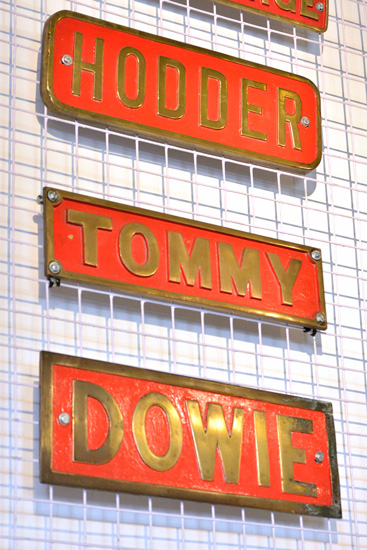This week I finally got to pay my first visit to the Talyllyn Railway, and amazingly (given my track record where visits to Wales are concerned) in glorious weather!
Whilst waiting for No.1 'TALYLLYN' to arrive with our train Joy and I had a wander around the Narrow Gauge Railway Museum at Tywyn Wharf and came across these…
 HODDER, TOMMY & DOWIE nameplates, NGRM, 16/8/13
HODDER, TOMMY & DOWIE nameplates, NGRM, 16/8/13
HODDER, TOMMY and DOWIE, nameplates from three steam locomotives that once worked a line very close to where I grew up (albeit well before my time!)
The line in question was (unusually for the UK) a metre gauge concern that carried limestone from Cliff Quarry in Crich, Derbyshire (now home to the Crich Tramway Village) down to lime kilns by the side of the North Midland Railway line at Ambergate, constructed by none other than George Stephenson, renowned as the 'Father of Railways' and was opened in 1841 using a mixture of self-acting inclines and horses to move the wagons.
DOWIE was the first steam locomotive to arrive in 1893 being constructed by Markham and Co. Ltd. of Chesterfield at a cost of £500. A De Winton & Co. 'coffee-pot' purchased from an unknown source in 1899 became the first of two locomotives to be named TOMMY but wasn't a huge success, eventually being replaced by a secondhand locomotive identical to DOWIE built in 1889 by Oliver & Co. Ltd. of Chesterfield (who later changed their name to Markham and Co.)
HODDER (a Peckett dating from 1924) was the fourth and final steam locomotive bought for the line in 1934 from William Twigg, an engineering dealer at Matlock. A much larger locomotive than DOWIE and TOMMY, HODDER had to be cut-down in size but even with a severely truncated chimney it still only cleared the village tunnel roof by a couple of inches.
Cliff Quarry (although reopened at a later date in a limited capacity) and the railway closed in May 1957 without ceremony and as far as I am aware none of the steam locomotives survive.

No comments:
Post a Comment